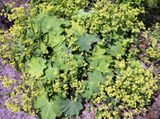Alchemilla
| Alchemilla | |
|---|---|

| |
| Illustration of Alchemilla vulgaris from 1917–1926 | |
| Scientific classification | |
| Kingdom: | Plantae |
| Order: | Rosales |
| Family: | Rosaceae |
| Subfamily: | Rosoideae |
| Tribe: | Potentilleae |
| Genus: | Alchemilla |
| Species: | A. vulgaris |
| Binomial name | |
| Alchemilla vulgaris | |
Alchemilla or Lady's Mantle is a perennial plant that flowers in late spring and summer. It is found both in the wild and in cultivated gardens. It especially grows in the colder regions of the north beyond the arctic circle and only on high mountain ranges such as the Himalayas in southern latitudes.[1]
The whole herb can be gathered and dried in June and July when in flower and when the leaves are at their best. It is applied in the form of teas and extracts. The root is sometimes also employed, generally fresh. No side-effects are noted.
It is traditionally used as a woman's healing herb. It contains salicylic acid, which is also found in the bark of the willow tree and the active ingredient in aspirin. It has sedative properties that help to alleviate cramps and painful menstruation. It has astringent properties because of the tannin it contains. It was traditionally seen as one of the best wound herbs. Cuts, scrapes and burns can be treated with skin washes of lady's mantle to prevent infection. A strong decoction of the fresh root has also been recommended as excellent to stop all bleeding.
Garden Journal
- See also Garden Journal for a list with all plants with a garden journal section.
June 19, 2012 - This Lady's Mantle plant grows in my garden since two years. It thrives although it grows in infertile sandy soil.
See also
References
External links
- Alchemilla Wikipedia
- Lady's Mantle A Modern Herbal by Mrs. M. Grieve

